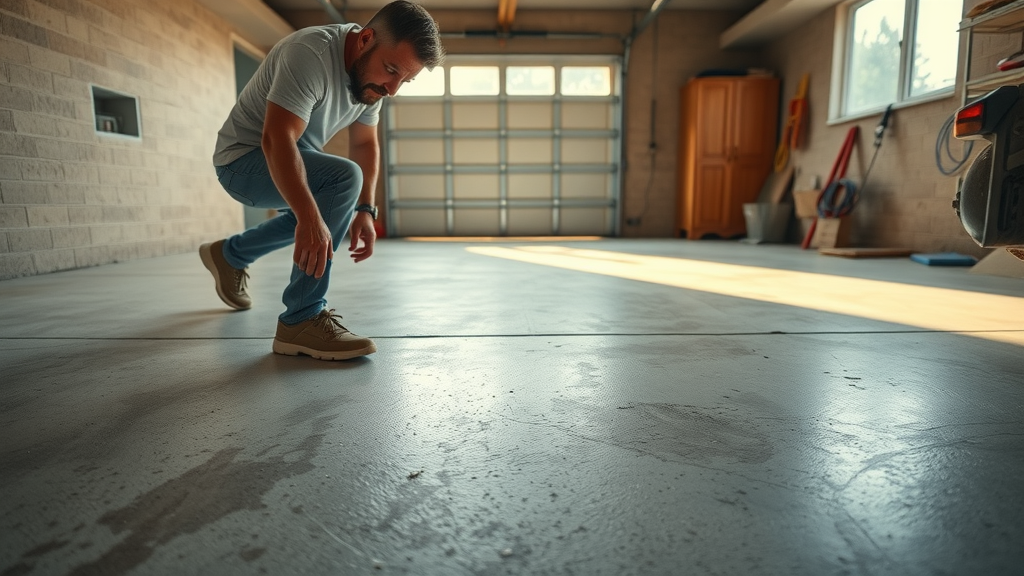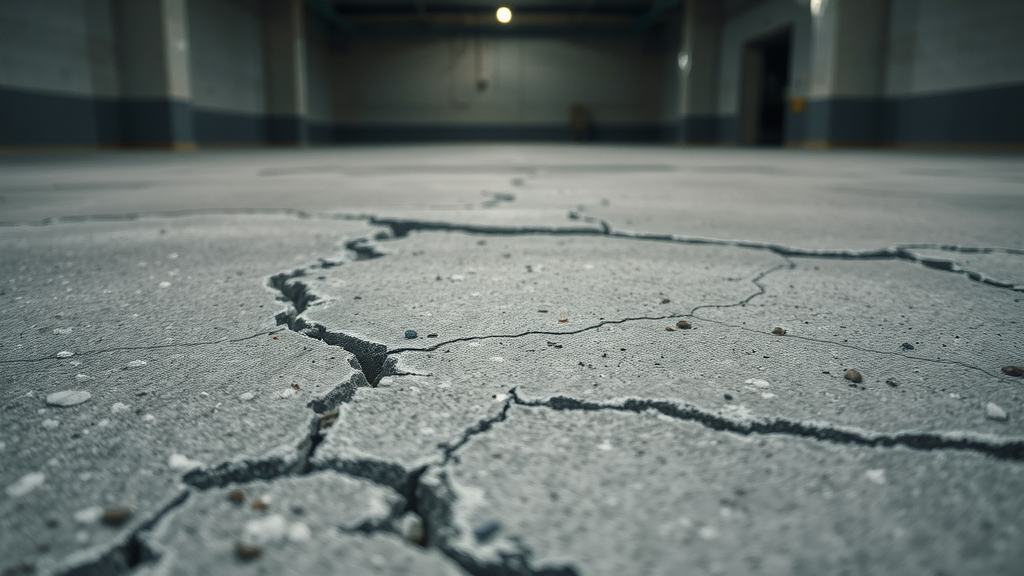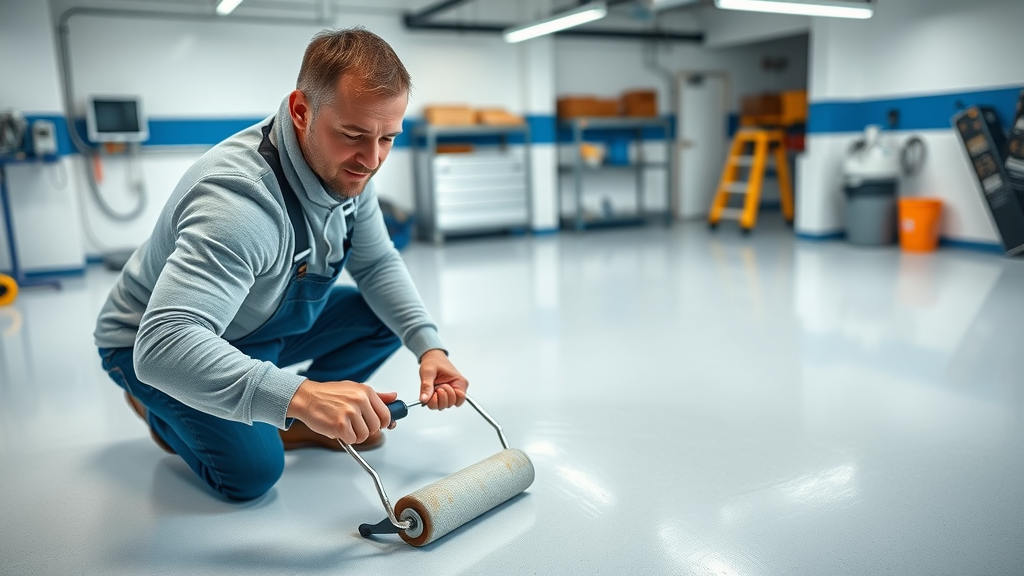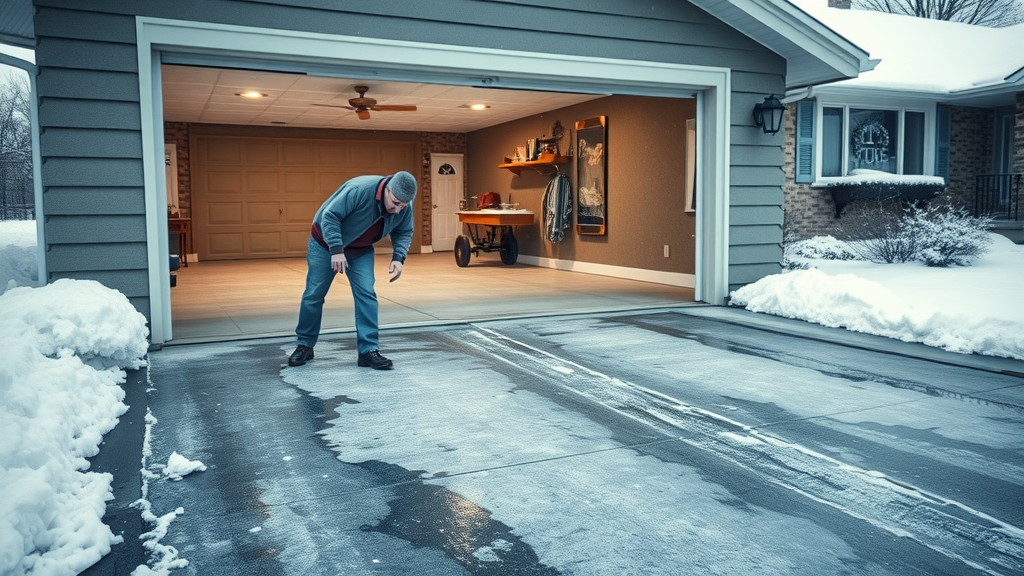Did you know that salt damage can silently devour your garage floor—costing you thousands if ignored? Every winter, as road salt and deicing fluids are tracked in, your concrete garage floor faces an invisible enemy. Don’t let your home’s most hardworking surface turn into a costly repair nightmare. In this guide, you’ll discover the real risks of garage floor salt damage, how to identify early warning signs, and proven fixes to keep your concrete garage floor spotless, strong, and protected—before it’s too late.
Shocking Facts: Why Garage Floor Salt Damage Could Ruin Your Investment
"Over 80% of concrete garage floors in cold regions show early signs of salt damage within five years, costing homeowners thousands in repairs." — National Concrete Consortium
Garage floor salt damage is a ticking time bomb for homeowners—especially in colder climates where road salt and deicing fluids are used heavily every season. The magic of these materials lies in making roads safer, but their hidden cost is the gradual destruction they inflict on your concrete garage floor. As salty water seeps into cracks and pores, it reacts with concrete and steel reinforcement, leading to surface flakes, crumbling, and even structural instability. Studies show that salt damage can decrease your home’s value, making a once-smooth garage slab rough, stained, and potentially dangerous.
The financial threat is real: even a small area of damaged concrete can require expensive repairs, and in the worst cases, a full replacement of the concrete garage floor—costing several thousand dollars. Homeowners often underestimate how fast road salt can wreak havoc, mistaking white stains for minor imperfections while hidden subsurface corrosion continues unabated. Understanding and tackling garage floor salt damage early is essential for protecting your investment and keeping maintenance costs manageable.

What You'll Learn About Garage Floor Salt Damage
- The science behind garage floor salt damage and road salt corrosion
- Step-by-step solutions to prevent future salt damage on your concrete garage floor
- How to repair damaged concrete and remove salt stains
- The role of garage flooring coatings like polyaspartic in salt protection
Understanding Garage Floor Salt Damage: Science & Causes
How Road Salt and Deicing Fluids Cause Damage to Concrete Garage Floors
When winter hits, the biggest enemy of your concrete garage floor arrives on your car’s tires: road salt and deicing fluids. Most road salts, like sodium chloride and calcium chloride, dissolve in melted snow and are tracked into your garage. Once inside, this salty water seeps into the tiniest pores and cracks in the concrete surface. Here, road salt triggers chemical reactions that break down both the surface of the concrete and, over time, any protective coatings. As the water evaporates, salts continue to attack, causing internal stress that leads to chipping, pitting, and even corrosion of steel reinforcements. This results in damaged concrete that loses strength and rapidly deteriorates if left untreated.
Unlike dirt or normal stains, salt stains signal deeper issues on your garage floor. While concrete can withstand a lot, it is not immune to the effects of repeated exposure to deicing agents. Over multiple winters, these salts amplify freeze-thaw cycles, expand cracks, and make your concrete floor brittle. Without intervention, your garage flooring turns from a strong, glossy surface into a rough, unsightly, and structurally compromised slab.
Identifying Early Signs of Salt Damage on Garage Floors
Knowing what to watch for can save your concrete garage floor from irreversible harm. Early indicators often appear as white salt stains or powdery residue (efflorescence) on the surface. At first, these may seem like cosmetic blemishes, but they are actually evidence that road salts are reacting with the concrete. With time, these stains grow and are soon followed by dark spots, surface flaking, and tiny cracks—signs that the salt is breaking down not just the top, but deep inside the concrete slab.
If ignored, what starts as subtle salt residue turns into larger cracks, spalling (chipping off of surface pieces), and in severe cases, pitted areas where concrete chunks break away entirely. A quick test: pour a small amount of warm water on a stained spot—if the surface bubbles, it’s a sign salts are still reacting. Spotting these warning signs early enables you to take action before minor problems require costly repairs, helping you prevent salt from causing long-term damage.
Salt Stains vs. Damaged Concrete: What’s the Difference?
It’s important to distinguish between surface salt stains and deeper damaged concrete. Surface stains look like white, chalky marks, easily wiped off but quick to reappear with each new winter. However, these stains are the first sign that road salts are in play. On the other hand, damaged concrete is revealed by rough patches, crumbling edges, and persistent cracks—symptoms that the problem has progressed well below the surface.
Understanding the difference shapes your response: stains call for thorough cleaning and application of a protective floor coating, while structural damage requires concrete repair before any new coating goes down. By acting quickly when you notice the first salt stains, you can avoid the expensive and complex process of repairing severely damaged concrete later on.
The Hidden Dangers of Garage Floor Salt Damage
- Structural weakening of concrete garage floors that can compromise your home’s safety
- Accelerated corrosion of garage flooring and embedded steel elements
- Costly long-term repairs from untreated salt stains that turn into major deterioration

Types of Garage Flooring Most Vulnerable to Salt Damage
Concrete Garage Floors Under Attack: Surface & Subsurface Issues
Concrete garage floors are particularly susceptible to both surface and subsurface damage from road salts and deicing fluids. The surface of the concrete suffers first—white stains, dull patches, and eventually rough areas where the concrete becomes brittle and starts to pit. However, the real threat lies beneath: road salt-laden water infiltrates hairline cracks and pores, reaching steel reinforcements and causing them to rust. This rusting swells inside the concrete, turning invisible damage into surface cracks, spalling, and, over time, significant structural risk.
Because the substructure is often hidden, many homeowners underestimate the severity until large chunks begin flaking away, or hollow sounds are detected when tapping the surface. If left unchecked, these issues can develop into serious weakness, resulting in a dramatically shortened lifespan for your garage floor. That’s why using proper floor coatings and regular inspection is critical—even for relatively new concrete garage floors.
How Damaged Concrete and Garage Floors Differ in Salt Resistance
Once a concrete floor is compromised—through minor cracks, chips, or older repairs—its resistance to road salts plummets. New, sealed concrete repels moisture and salts reasonably well, but as soon as protective layers are worn or missing, the path is wide open for deicing fluids to penetrate. Damaged concrete acts like a sponge, soaking in salty water and amplifying damage each season.
Other garage flooring options, like vinyl tiles or rubber mats, offer some protection but can trap moisture beneath them, leading to hidden salt damage below. Only advanced coatings—like polyaspartic coatings—provide a robust shield against both direct surface attack and subsurface infiltration, keeping even previously damaged floors safe from ongoing salt exposure.
Road Salts, Deicing Fluids, and Their Effects on Various Garage Flooring Types
Not all garage floors are created equal in the fight against road salt. Concrete remains the most common and the most vulnerable, quickly pitted and stained if not protected. Epoxy-coated surfaces resist salt for a while but can peel or become slippery if not applied professionally or if the underlying concrete is already compromised. Simple acrylic sealers provide only short-lived defense, needing reapplication every few years. Rubber and plastic tiles may protect the visible surface but do little for the actual concrete slab below if moisture gets underneath.
Polyaspartic coating emerges as the strongest barrier, forming a watertight, UV-stable, chemical-resistant layer that withstands heavy road salt and deicing fluids, as well as household chemicals, oil spills, and abrasions. Choosing the right solution based on your climate and usage is key to preventing irreversible salt damage to your garage floor.
Recognizing and Repairing Garage Floor Salt Damage
How to Spot and Diagnose Salt Stains and Concrete Floor Deterioration
Detecting garage floor salt damage early helps avoid large expenses down the road. Begin by inspecting your garage for white streaks or chalky patches—these salt stains are caused by the migration of soluble salts left behind as salty water dries. Check for thin cracks and rough patches near the perimeter where snow and slush are tracked in. Test these areas with warm water; active bubbling often signals a chemical reaction from lingering salt. Tap on the surface—hollow sounds or crumbling edges indicate a loss of underlying bond and a need for immediate action.
Besides looking for damage, feel for uneven spots underfoot—subsurface voids can develop as salt eats away the underlying cement. Timely identification of even small patches of damaged concrete lets you repair before deterioration spreads, protecting both your garage floor and the value of your home.
Top Methods for Repairing Damaged Concrete from Salt
"Timely intervention is key. Addressing salt damage early can extend your concrete garage floor’s life by over a decade." — John Mason, Certified Flooring Contractor
Repairing salt-damaged concrete starts with a thorough cleaning—remove all surface salt stains and debris using a stiff brush and warm water mixed with detergent or specialty salt removers. For more stubborn areas, use a pressure washer on a low setting to avoid worsening cracks. Once the surface is clean and dry, inspect for flaked, loose, or crumbled concrete. Chip away weakened spots and use a concrete patching compound to restore the surface, ensuring deep cracks are filled and sealed completely.
Once repairs cure, consider finishing with a professional polyaspartic coating to seal the fresh repairs, providing both a slick, glossy look and maximum protection against future salt infiltration. This final layer not only shields from road salts and deicing fluids but also enhances resistance to other garage spills and abrasions. Timely repair and proactive sealing are the best ways to save thousands in costly repairs down the line.
Below: Watch our animated guide for a step-by-step walkthrough on cleaning, repairing, and sealing salt damage on your garage floor—from essential tools and patching techniques to dramatic before and after comparisons.
Best Ways to Remove Salt Stains from Garage Floors
- Effective cleaning products for salt stains
- Home remedies for removing salt from garage flooring
- Step-by-step procedures for a spotless concrete floor

Preventing Garage Floor Salt Damage: Protective Coatings and Barriers
Why Polyaspartic Coating is Leading the Way for Garage Floor Salt Protection
Out of all garage floor coatings, polyaspartic coating stands as the most advanced solution for protection against salt. Unlike traditional epoxies or acrylic sealers, polyaspartic formulas offer exceptional resistance to road salts, repeated freeze-thaw cycles, abrasion, and even UV rays—all threats common in busy family garages. They cure rapidly, forming a seamless, watertight shield above both new and repaired concrete garage floors.
Polyaspartic coatings don't just protect—they beautify your garage floor with a high-gloss finish that resists stains, tire marks, and chemicals. They’re also less sensitive to humidity and temperature swings, making them reliable in both winter and summer. While installation by a professional is recommended for maximum durability, the investment pays off in years of reduced maintenance, far fewer repairs, and continuous confidence that your garage floor is safe from salt attack.
| Coating Type | Salt Resistance | Durability | Cost |
|---|---|---|---|
| Polyaspartic | Excellent | 20+ years | $$$$ |
| Epoxy | Good | 10 years | $$ |
| Acrylic Sealer | Fair | 3 years | $ |
| No Coating | Poor | <2 years | - |
DIY vs. Professional Garage Floor Protection Methods
While numerous DIY solutions exist for protecting your garage floor from salt, they are rarely as durable as professional treatments. DIY kits typically involve water-based epoxy or acrylic sealers, which provide a decent first line of defense but must be reapplied frequently and are sensitive to moisture during installation. On the other hand, hiring professionals for a polyaspartic coating application guarantees proper surface preparation, high-quality materials, and long-lasting results. Professionals can also seal cracks and reinforce weak spots—something most DIY kits cannot address effectively.
For homeowners who want peace of mind and serious long-term protection, investing in a professional polyurea or polyaspartic coating is worth the initial cost, paying for itself in avoided costly repairs and ongoing maintenance. If you decide on a DIY approach, start with a meticulous cleaning, thorough repair, and prompt application of multiple thin coats to maximize durability.

Step-by-Step Guide: How to Protect Your Concrete Garage Floor from Salt Damage
- Inspect and clean your concrete garage floor. Remove dirt, dust, and especially old salt stains using warm water and a pH-neutral cleaner.
- Repair existing damaged concrete. Patch cracks, chips, and spalled areas with a concrete repair compound, allowing it to fully cure.
- Apply a suitable protective coating. Polyaspartic coatings are recommended for their superior resistance against road salt, chemicals, and abrasions.
- Seal all cracks and edges. Pay special attention to corners and joints where moisture can penetrate; use a flexible sealant to ensure a watertight finish.
- Institute regular cleaning routines. Sweep and mop the garage floor regularly throughout the winter to prevent future salt buildup and keep the coating in top shape.

Maintenance Tips: Prevent Salt Stains and Future Salt Damage
- Establish a routine cleaning schedule—at least once a month during winter, more often after snowstorms
- Use best cleaning solutions such as pH-neutral detergents and warm water to remove residue without harming floor coatings
- Adopt simple habits to avoid floor from salt damage. Always sweep before rinsing, avoid letting puddles dry on the surface, and use waterproof garage mats at entry points
People Also Ask: Garage Floor Salt Damage Questions Answered
Can concrete damaged by salt be repaired?
Yes, damaged concrete from salt can be effectively repaired if caught early. Begin by removing all loose material and cleaning the area thoroughly to eliminate lingering salt stains. Fill any cracks or pits with a high-quality repair compound designed for garage floors. Once cured, sealing the area with a durable polyurea or polyaspartic coating can prevent future salt intrusion and prolong the life of your concrete floor.
How do you get salt off a garage floor?
Remove salt stains quickly by sweeping and vacuuming loose debris, then dissolving salt residue using warm water mixed with a mild, pH-neutral cleaner or vinegar solution. For stubborn spots, use a stiff brush for scrubbing. Rinse well and dry the area, repeating as necessary to restore your garage floor to a spotless finish. Avoid harsh acids, which can further damage the concrete surface.
How long does it take for salt to damage concrete?
Evidence of salt damage can appear in as little as one or two winter seasons, and visible salt stains usually signal deeper chemical reactions already at work. Left untreated, minor surface stains can progress to structural issues within five years, according to researchers.
How do I protect my garage floor from salt?
The best way to protect your garage floor from salt is by applying a resilient coating like polyaspartic or epoxy. This prevents penetration of road salts and deicing fluids. Pair this with regular cleaning, prompt repair of visible cracks, and use of waterproof mats to further decrease the risk of salt damage.
Key Takeaways: Garage Floor Salt Damage Prevention
- Garage floor salt damage is preventable with the right products and routines
- Regular maintenance extends the life of your concrete garage floor and saves money long-term
- Polyaspartic coatings offer superior protection against salt stains, damaged concrete, and chemical spills

Expert FAQs: Garage Floor, Salt Damage, and Long-Term Solutions
- What’s the best garage flooring for preventing salt damage? Polyaspartic-coated concrete floors offer the most long-term protection, far exceeding epoxy and acrylic alternatives in performance and lifespan.
- Should you choose polyaspartic coatings over epoxy for garage floor salt protection? Yes—polyaspartic coatings cure faster, are more durable, more resistant to chemicals, and remain stable in varying temperatures. This makes them ideal for protection against salt and general garage wear.
- How do you handle severely damaged concrete garage floors? Severe damage may require removing extensively compromised sections and re-pouring new concrete. Always finish with a high-performance floor coating to prevent future issues. For minor to moderate damage, patching and sealing are usually sufficient.
Conclusion: Safeguard Your Garage Floor From Salt—Act Now
Protect your concrete garage floor from salt damage today for a safer, longer-lasting, and more valuable home.
Call to Action: Get Professional Help to Prevent Garage Floor Salt Damage
Call Us now to get your FREE Quote! 800-280-9210
To further enhance your understanding of garage floor salt damage and its prevention, consider exploring the following resources:
-
“How to Prevent, Clean, and Repair Salt Damage on Your Concrete Garage Floor”: This comprehensive guide delves into the causes of salt damage, effective cleaning techniques, and preventive measures to protect your garage floor. (lynxconcretecoatings.com)
-
“Restore Your Garage Floor from Salt Stains and Winter Damage”: This article offers practical steps for removing salt stains and repairing winter damage, ensuring your garage floor remains in top condition. (allgaragefloors.com)
By consulting these resources, you’ll gain valuable insights and actionable steps to safeguard your garage floor against the detrimental effects of road salt.
 Add Row
Add Row  Add
Add 



Write A Comment